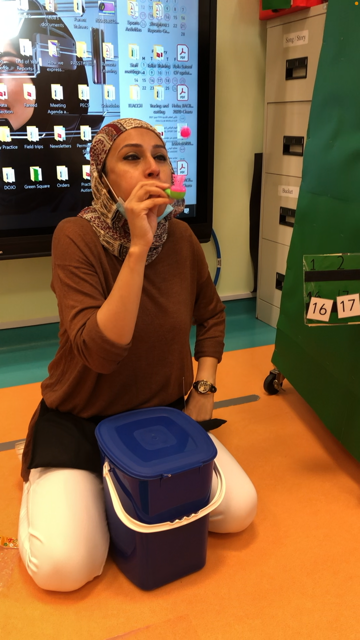For most people, change and uncertainty are difficult. For my students with autism and their parents, change and uncertainty can be overwhelming. That is why when I look back at our experience living through the pandemic, I am in awe of how we were able to turn a very challenging year into one of the most rewarding.
I am an early intervention autism teacher at Renad Academy, a school designed to meet the needs of children with autism in Qatar Foundation’s Education City. Over time, I’ve learned that when you teach children with autism, you have successes, challenges and failures – all wrapped up in one. Once school officials alerted us that we would be entering a lockdown period, I only had a few hours to pack up my materials and start figuring out how to translate a high-touch, interactive teaching environment to a virtual format. I was in for a trying time full of change without a clear end in sight.
Aside from being a teacher, I am also a mother of three boys. My youngest is eight years old and was born with congenital heart disease, which led to three open heart surgeries all under the age of five. This perspective as a parent has helped me relate to parents of students with special needs even more. From the early days of the pandemic, I acutely felt how much they needed my help to support their children emotionally, socially and academically amid a completely disrupted learning environment.
While I’ve grown accustomed to a very specific way of teaching my students, I found that I was forced to embrace the chaos and lean into experimentation. Because students with autism need routine and learn best through sensory activities, the early days consisted of a lot of trial and error. To start, I built a makeshift classroom space at my home that included our usual calendar, felt board, and classroom rules, and began recording video lessons for my students to watch. I asked parents for feedback on how their children responded and as expected, feedback was varied – no single child with autism is alike. Some students watched the videos, some couldn’t. I then shifted to holding classroom sessions on Zoom, so I could interact with the students face-to-face. That didn’t work for the majority of students either.
To turn things around, I switched gears and became more of a facilitator to parents, coaching them to find ways to work with their children on very specific goals. Instead of making videos for children, I started making videos for their parents educating them how to implement strategies that we use at school, at home, which was challenging.
Understandably, parents became frustrated with these new systems, so it became important to dig deep into my sense of empathy, especially as a parent with my own three young children at home. While at home, parents started began complaining about problem behaviors their children had started exhibiting, including regression in toileting and communication, refusal to work, etc. I remember feeling helpless, and that made me really frustrated, but I called every parent and reassured them that we would find a way and absorb this change, even though I wasn’t that confident myself.
After nearly a month, I started observing a shift from feelings of frustration to feelings of empowerment. Thanks to our collective effort, there was a new level of harmony and bonding taking place between my students and their parents, who rediscovered their relationship with their children. Parents started sending me videos of themselves teaching their children, some for the first time in their lives. These videos were so wonderful to watch as I could see how parents started challenging themselves and their abilities to best support their children; they were changing their home environment to be more autism-friendly, encouraging my students to play and interact with siblings, using visuals, taking courses and educating themselves on different autism-related subjects. I am proud and inspired by the progress many of our children made despite all the odds.
This whole experience has profoundly changed my life as a teacher and a parent. I was so lost in the beginning, not knowing how to best support my students and my children. But gradually, with creativity, dedication and open communication with my students’ parents, and even my own children’s teachers, I started making sense of what needed to be done to succeed in this new normal. There is no doubt the past year has been difficult for everyone, but I am proud of my students and their families for persevering and turning challenges in to opportunities. We are all coming out of this experience better and stronger. In a very strange way, the pandemic reignited my passion for my profession.



